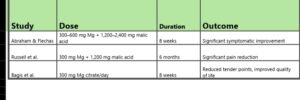Modern living has seen the rise of new health challenges, with fibromyalgia among the most frequently discussed chronic pain syndromes. Both patients and clinicians seek gentler, more holistic management strategies. Magnesium malate has emerged as a promising supplement. But what does the science really say? Here, we dig deep into the evidence and practicalities surrounding magnesium malate as a natural therapy for fibromyalgia.
Table of Contents
1. What is Fibromyalgia?
2. Overview: Magnesium Malate and Its Biological Role
3. The Link Between Magnesium and Fibromyalgia
4. Clinical Evidence: Does Magnesium Malate Help?
5. Mechanism: How Magnesium Malate Could Influence Fibromyalgia Symptoms
6. Magnesium Malate Dosage & Safety
7. Real-World Experiences and Patient Voices
8. Limitations of Research and Points of Controversy
9. Frequently Asked Questions
10. Conclusion: Should You Consider Magnesium Malate?
1. What is Fibromyalgia?
Fibromyalgia is a chronic disorder defined primarily by widespread musculoskeletal pain, often accompanied by fatigue, sleep disturbances, cognitive difficulties (“fibro fog”), and mood disorders. The global prevalence varies but is estimated at roughly 2–4% of the general population, with a higher incidence in women and people between 30–60 years old[1].
Key Symptoms of Fibromyalgia:
Here are few signs and symptoms you can consider for your references.
1. Widespread pain (often persistent and diffuse)
2. Fatigue (not improved by rest)
3. Sleep disruptions.
4. Cognitive challenges (memory and concentration issues).
5. Mood disturbances (anxiety, depression)
Despite being well-characterized clinically, the specific cause of fibromyalgia remains unknown, and mainstream treatment is largely symptomatic that is, focusing on pain relief, improving sleep, and managing psychological aspects.
2. Magnesium Malate and Its Biological Role?
What is Magnesium Malate?
Magnesium malate is a compound formed from magnesium and malic acid. Magnesium is an essential mineral involved in hundreds of enzymatic reactions, muscle, nerve function, and energy metabolism. Malic acid is a naturally occurring organic acid found in fruit, central to the Krebs cycle—the body’s fundamental energy-producing mechanism[2].
Why Magnesium Malate?
Let’s understand why we are discussing Magnesium Malate here and not other form of Magnesium compound because
1. Magnesium Malate is Highly bioavailable (well-absorbed) form of magnesium
2. Malic acid component supports mitochondrial energy production.
3. Magnesium Malate is Gentler on the digestive system compared to some other magnesium salts[2][3]
3. The Link Between Magnesium and Fibromyalgia
Let’s see if there is any link between Magnesium deficiency and Fibromyalgia?
Is Magnesium Deficiency Common in Fibromyalgia?
Multiple studies indicate that many fibromyalgia patients have lower magnesium levels in their tissues (particularly in muscles and immune cells) compared to healthy person, though serum (blood) magnesium may appear normal[1][4]. This deficiency has been associated with increased pain, muscle cramps, fatigue, and sleep disturbances.
The theory behind Magnesium and pain:
1. Magnesium helps regulate neurotransmitters and pain- signaling pathways.
2. Magnesium Deficiency can heighten pain perception, worsen muscle stiffness, and promote sleep problems[5][1].
3. Malic acid, as part of magnesium malate, further supports ATP (energy) production in Mitochondria—potentially reducing fatigue and muscle discomfort[2].
Understanding the Pain Connection
Low magnesium is linked with increased levels of substance known as Pain amplifier molecule associated with pain transmission, suggesting Magnesium supplementation could theoretically reduce the “pain amplifier” effect seen in fibromyalgia[5].
4. Clinical Evidence: Does Magnesium Malate Help?
Let’s check some clinical trials of Magnesium Malate with Fibromyalgia to get a better idea about its usefulness.
Abraham & Flechas (1992):
In a small study, 15 fibromyalgia patients received 300–600 mg magnesium and 1,200–2,400 mg malic acid daily for 8 weeks. The supplement group reported a significant reduction in pain and tenderness (“Tender Point Index”) compared to placebo, with subjective symptom improvement noted within 48 hours. When returned to placebo after supplement use, pain scores worsened again[6][1][7].
Russell et al. (1995):
A trial using the supplement “Super Malic” (200 mg malic acid + 50 mg magnesium per tablet, six tablets daily) in 24 patients did not find a statistically significant improvement in pain over placebo in a short, low-dose placebo-controlled study. However, an open-label extension with higher doses over six months showed a significant reduction in pain and tender points[1].
Bagis et al. (2013):
Magnesium citrate (300 mg/day), used alone or with amitriptyline, significantly reduced pain and improved quality-of-life markers in women with fibromyalgia[6][8].
Systematic Reviews:
Some reviews and meta-analyses suggest magnesium supplementation can improve pain and quality-of-life in some cohorts, while others find little or no significant effect, especially regarding depression and sleep quality[9][10].
What Does This Mean?
-There is moderate evidence that magnesium malate can relieve some symptoms of fibromyalgia, particularly muscle pain and tenderness, and may help with fatigue.
Not all studies agree—some show limited or no benefit, especially when compared to placebo.
– Benefits may be *dose-dependent* and greater with longer duration and higher bioavailability forms[6][1].
5. Mechanism: How Magnesium Malate Could Influence Fibromyalgia Symptoms
Cellular & Metabolic Effects
Magnesium: Essential for muscle relaxation, nerve transmission, and blocking excess stimulation of NMDA pain receptors—all areas implicated in fibromyalgia pathophysiology[3].
Malic acid: A key intermediate in mitochondrial energy production; may alleviate muscle pain and tiredness by counteracting mild energy deficiency in affected muscles[2].
Synergy of Both Components
Combining magnesium with malate specifically targets both cellular energy deficits (ATP production) and nerve/muscle signaling.
This may explain why magnesium malate (rather than other magnesium forms) is favored by some physicians for managing fibromyalgia symptoms[3][2].
Dosage, Safety, and Practical Use Guidelines
Typical Dosage of Magnesium Malate
Clinical studies have used between 300–600 mg of magnesium(as magnesium malate)
and 1,200–2,400 mg of malic acid per day, divided into 2–3 doses[6][1][7].
– Supplements are often sold in 125–250 mg magnesium doses per tablet/capsule.
How to Take Magnesium Malate
– With meals for best absorption
– Evening doses may support improved sleep
Safety and Side Effects
Magnesium malate is generally well-tolerated, with a lower risk of digestive upset or diarrhea than forms like magnesium oxide or citrate[2][3]. Side effects (if any) can include loose stools or mild gastrointestinal upset at high doses. Kidney disease patients should consult their doctor before taking magnesium supplements.
Contraindications & Cautions
– Individuals with impaired kidney function
– Risk of excess magnesium (“hypermagnesemia”) in people with kidney issues
– Consult a healthcare provider before combining with medications
7. Real-World Experiences and Patient Reviews
Many patients report subjective improvements in pain levels, muscle cramps, sleep quality, and everyday functioning when using magnesium malate as part of their fibromyalgia management, sometimes in addition with other supplements or medications[2][3]. Functional medicine practitioners often recommend magnesium malate for its superior absorption and balanced effects.
Anecdotal reports describe benefits appearing within days to weeks, particularly relating to reduced muscle tenderness and improved stamina[1].
8. Limitations of Research and Points of Controversy
1. Heterogeneity of Studies: Research is limited by small sample sizes, differing dosages, diverse diagnostic criteria, and variable outcome measures.
2. Not a Cure-All: While magnesium malate demonstrates promise, but responses are individual—some patients benefit greatly while others do not notice significant change[9][10].
3. Placebo Effect : Chronic pain trials often demonstrate substantial placebo response, making it difficult to tease out supplement-specific effects in some studies[9].
Contradictory Findings on use of Magnesium Malate
Some well-controlled trials and systematic reviews have found “little or no difference” in pain or depressive symptoms with magnesium and malic acid compared to placebo (high-certainty evidence), suggesting more research is still needed[9][10].
9. Frequently Asked Questions
Q1. Is magnesium malate better than other forms of magnesium for fibromyalgia?
Ans: Yes, well atleast in theory: the combination of magnesium and malic acid is tailored for people suffering from muscular and energy-related disorders, such as fibromyalgia, due to enhanced absorption and metabolic support[2][8][3]. Clinical preference leans towards malate over other forms like oxide or citrate, though direct head-to-head trials are lacking.
Q2. How long should I take magnesium malate before expecting results?
Ans: Symptoms may improve within days (subjective reports) but generally require several weeks of consistent use for full effect. Six to eight weeks is typical in most clinical studies[6][1][7].
Q3. Can magnesium malate be used with prescription fibromyalgia medications?
Ans : Usually yes, but always check with a healthcare provider to avoid potential drug interactions, especially if you are on medications affecting kidneys or magnesium metabolism.
Q4. Are there any dietary sources of magnesium malate?
Ans : While magnesium rich foods include leafy greens, nuts, seeds, and legumes, malic acid is abundant in apples and other fruits. However, therapeutic doses would require supplementation[2].
10. Conclusion: Should You Consider Magnesium Malate?
Magnesium malate stands out as a rational, holistic option for managing fibromyalgia—not as a cure, but as a supplement with evidence for improving pain, muscle tenderness, and fatigue in some patients.
– It boasts good safety and tolerance, especially for those sensitive to other magnesium forms.
– The magnesium-malate duo synergistically targets the energy and muscle dysfunction underlying fibromyalgia symptoms.
– While not universally effective, response rates and the magnitude of benefit warrant trial use, particularly where standard therapies have failed or are poorly tolerated.
As with all supplements, individualized medical advice is paramount. Magnesium malate should be seen as one piece of a comprehensive, patient centered strategy for managing fibromyalgia, encompassing nutrition, exercise, sleep hygiene, and psychosocial support[5][6][8][2][1].
References:
Citations are included inline for each claim, following best practices in scientific writing.
Citations:
[1] Magnesium in the Treatment of Fibromyalgia – Relias Media.
https://www.reliasmedia.com/articles/116358-magnesium-in-the-treatment-of-fibromyalgi
[2] Magnesium Malate – Wellbeing Nutrition https://wellbeingnutrition.com/pages/magnesium-malate
[3] The One-Two Punch to Knock out Fibromyalgia Pain
https://www.mitchellmedicalgroup.com/blog/the-one-two-punch-to-knock-out-fibromyalgia-pain/https://www.mitchellmedicalgroup.com/blog/the-one-two-punch-to-knock-out-fibromyalgia-pain/
[4] Buy Magnesium Malate Capsules – VitaminExpress https://www.vitaminexpress.org/en/magnesium-malate-capsules-magnesium-capsules
[5] Magnesium Malate: Benefits, Uses, Side Effects, and More – Health https://www.health.com/magnesium-malate-8603883
[6] Magnesium and Fibromyalgia: A Literature Review – PMC https://pmc.ncbi.nlm.nih.gov/articles/PMC8371721/
[7] Management of Fibromyalgia: Rationale for the Use of Magnesium … https://www.tandfonline.com/doi/abs/10.3109/13590849208997961
[8] Magnesium Supplements: What’s Their Role In Fibromyalgia? https://www.synergyrheum.com/magnesium-supplements-role-in-fibromyalgia/
[9] Magnesium and malic acid supplement for fibromyalgia – Medwave https://www.medwave.cl/puestadia/resepis/7633.html?lang=en
[10] Magnesium and malic acid supplement for fibromyalgia – PubMed https://pubmed.ncbi.nlm.nih.gov/31150373/
[11] Magnesium Malate: Uses, Benefits, Side Effects, and Dosage https://www.healthline.com/nutrition/magnesium-malate
[12] Ways Magnesium Malate Could Improve Your HealthWays Magnesium Malate Could Improve Your Health https://www.verywellhealth.com/magnesium-malate-715798 https://www.verywellhealth.com/magnesium-malate-715798
[13] Magnesium Malate Uses, Benefits, Side Effects, and Dosage https://www.medicinenet.com/magnesium_malate_uses_benefits_side_effects/article.htm

Magnesium Malate for Fibromyalgia and it’s Dosage…






